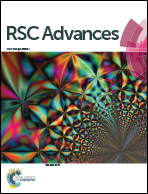The influence of hierarchical TiO2 microspheres on the trap state distribution and charge transport/recombination dynamics in quantum dot sensitized solar cells
Abstract
Two different kinds of quantum dot sensitized solar cells (QDSSCs) were fabricated based on the photoanode materials P25 (Cell-P25) and hierarchical TiO2 microspheres (HMS, Cell-HMS). The trap state distributions and charge transport/recombination dynamics are comparatively investigated by means of time-resolved charge extraction and transient photovoltage measurements. The dynamics results prove that, compared to Cell-P25, Cell-HMS possesses higher density and lower trap state energy characteristics, as well as a 30% lower charge transport rate. In addition, the boundary level dividing lower-voltage iso-energetic charge recombination and higher-voltage multiple-trap limited charge recombination is experimentally determined. Furthermore, Cell-HMS is found to exhibit a slightly higher boundary voltage and a 96% lower recombination rate with respect to Cell-P25. A physical model is proposed to describe the influence of trap state distribution on charge transport/recombination, highlighting the importance of photoanode morphology in optimizing the photovoltaic performance of QDSSCs.


 Please wait while we load your content...
Please wait while we load your content...